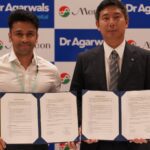New Delhi , August 05, 2018 :
Around the globe
- Researchers reported in the New England Journal of Medicine that 4 months of rifampin was noninferior to 9 months of isoniazid for the treatment of adults with latent tuberculosis (TB). The shorter regimen was also associated with higher rates of treatment completion and better safety.
- A study published August 2nd in the journal Cell Metabolism reveals that successful response to weight loss is associated with the early and sustained improvement in the functioning of pancreatic beta cells. This finding challenges the previous paradigm that beta-cell function is irreversibly lost in patients with type 2 diabetes.
- The Democratic Republic of Congo has announced a new outbreak of the deadly Ebola virus, just days after a recent emergence of the disease, which killed 33 people, was declared over. Four cases of the virus were confirmed in northeastern North Kivu province. A team of 12 experts are to set up a response operation.
- A man in Wisconsin man underwent amputation of lower legs and hands after developing a rare blood infection caused by bacteria called Capnocytophaga canimorsus, which is commonly found in the saliva of most healthy dogs and is usually not harmful to humans. The bacteria entered his blood stream causing sepsis.
Around the Nation
- Over 500 licensed water trolleys were seized in north Delhi after samples taken from them were found unfit for consumption. Civic body officials check the chlorine content of water during inspection of the trollies. According to WHO maximum amount of chlorine allowed in drinking water is 5 mg/l. These water samples were tested this year starting January 1 and the trolleys were seized by the authorities after they were found in violation of norms, the NDMC said.
- The Institute of Medical Sciences (IMS), Banaras Hindu University (BHU) has been formally upgraded to the level of All India Institute of Medical Sciences (AIIMS) on Saturday. IMS-BHU will now be entitled to get enhanced funding and better health care facilities. Its Sir Sunderlal Hospital is the only tertiary care referral centre for the entire eastern UP, western Bihar, Chhattisgarh, Jharkhand, Madhya Pradesh and neighbouring country Nepal catering to the medical needs of about 20 crore population.
- WHO lauds India’s commitment to accelerated coverage of safe sanitation services which, assuming 100% coverage is achieved by October 2019, could avert up to 300 000 deaths due to diarrheal disease and protein-energy malnutrition (PEM) since the country launched the Swachh Bharat Mission in 2014.
- According to ICMR India State-Level Disease Burden Study report “India: Health of the Nation’s States”, the estimated proportion of all deaths due to Non-Communicable Diseases (NCDs) has increased from 37.09% in 1990 to 61.8% in 2016.
- A parliamentary panel has asked the Union Health Ministry to make efforts to formulate a scheme to extend financial assistance to HIV/AIDS patients “at the earliest” (The Pioneer)
Current scenario of health care resources in India
- Total number of registered Allopathic doctors is 1,041,395 (up to 2017)
- Assuming 80% availability, an estimated 8.33 lakh doctors may be actually available for active service.
- Doctor-population ratio 1:1596 as against 1:1000 as prescribed by the WHO.
- Patient-bed ratio: 0.9 beds per 1,000 population
- Govt spending for health care: Rs 1,112 per capita, which means only Rs 3 per day is spent per day for the healthcare of an average Indian
- Health Sector spending 1.16% of the GDP (proposed to increase to 2.5% of the GDP in National Health Policy 2017)
- Govt. contribution to health insurance 32% (vs 83.5% in UK)
- Density of doctors at national level 79.7 per lakh population, of nurses and midwives 61.3 per lakh, and of dentists just 2.4 per lakh. Of all doctors, 77.2% were allopathic and 22.8% were Ayurvedic, Homeopathic or Unani.
- More than 60% of the registered doctors are concentrated in urban areas
- There are 476 medical colleges, 313 Colleges for BDS courses and 249 colleges which conduct MDS courses.
- There are 23,582 government hospitals having 710,761 beds in the country. 19,810 hospitals are in rural area with 279,588 beds and 3,772 hospitals are in urban area with 431,173 beds.
- 70% of population of India lives in rural area and to cater their need there are 156,231 Sub Centres, 25,650 Primary Health Centres and 5,624 Community Health Centres in India as on 31st March 2017.
- Total no. of licensed Blood Banks is 2903 (2017).
Dr KK Aggarwal
Padma Shri Awardee
Vice President CMAAO
President HCFI







